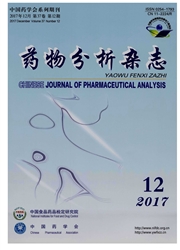

 中文摘要:
中文摘要:
目的:研究川续断皂苷Ⅵ在大鼠体内的代谢。方法:采用高效液相色谱-电喷雾质谱检测大鼠灌胃川续断皂苷Ⅵ后血浆、尿液、胆汁和粪便中的代谢产物。使用Agilent公司Zorbax Extend-C18色谱柱(150 mm×4.6 mm,5!m),以0.05%甲酸乙腈-0.05%甲酸水为流动相梯度洗脱(0~12 min,25%B→27%B;12~30 min,27%B→50%B;30~40 min,50%B→80%B;40~45 min,80%B→90%B;45~50 min,90%B),进行色谱分离,并与电喷雾质谱联用,毛细管电压为2.50 kV,锥孔电压为35 V,干燥气流速为320 L.h-1以及离子源温度为120℃,根据全扫描检测正、负离子模式下获得的准分子离子峰推测化合物的分子量信息及其可能的化学结构。结果:在大鼠血浆、尿液、粪便和胆汁中均检测到原型成分,粪便中检测到川续断皂苷Ⅵ脱去1分子(RM1,RM2)、2分子(RM3,RM4)及全部糖基(RM5)的5个代谢产物,血浆和胆汁中检测出脱去2分子葡萄糖残基的代谢产物(RM4),此外在胆汁中首次发现川续断皂苷Ⅵ的羟基化产物(RM6)。结论:川续断皂苷Ⅵ在大鼠体内的转化主要是在肠道的脱糖基代谢及在肝脏的羟基化反应。
 英文摘要:
英文摘要:
Objective: To study in vivo metabolism of asperosaponin Ⅵ in rats.Methods: High performance liquid chromatography-electrospray ionization / mass spectrometry(HPLC-ESI / MS) was used for analysis of metabolites of asperosaponin Ⅵ in plasma,urine,bile and feces in rats after intragastric administration.The separation was performed with a Zorbax Extend C18 column(150 mm × 4.6 mm,5 !m) using a binary gradient elution(0-12 min,25% B→27% B;12-30 min,27% B→50%B;30-40 min,50% B→80% B;40-45 min,80% B→90% B;45-50 min,90% B) with the mobile phase of 0.05% formic acetonitrile-0.05% formic acid water.The mass spectra were recorded under the full scan mode,with a capillary voltage of 2.5 kV,a cone voltage of 35 V,a drying gas flow rate of 320 L.h-1and an ion source temperature of 120 ℃.The quasi-molecular ions of compounds in both positive and negative modes were observed for molecule mass information,and the potential structures were presumed.Results: The parent component asperosaponin Ⅵ was found in rat plasma,urine,bile and feces,and five deglycosylation metabolites via cleavage of one glucose(RM1,RM2),two glucoses(RM3,RM4) and all glucoses(RM5) were detected in rat feces,among which the degradation product derived from asperosaponin Ⅵ via cleavage of two molecules of glucose(RM4) was also found in plasma and bile,in addition,hydroxyl asperosaponin Ⅵ(RM6) was first found in rat bile.Conclusion: The metabolic pathways of asperosaponin Ⅵ in rat are primarily deglycosylation in intestine and hydroxylation in liver.
 同期刊论文项目
同期刊论文项目
 同项目期刊论文
同项目期刊论文
 Revolving Door Action of BCRP Facilitates or Controls the Efflux of Flavone Glucuronides from UGT1A9
Revolving Door Action of BCRP Facilitates or Controls the Efflux of Flavone Glucuronides from UGT1A9 Metabolism Study of Notoginsenoside R(1), Ginsenoside Rg(1) and Ginsenoside Rb(1) of Radix Panax Not
Metabolism Study of Notoginsenoside R(1), Ginsenoside Rg(1) and Ginsenoside Rb(1) of Radix Panax Not Metabolite Profiles of Epimedin B in rats by Ultra-performance Liquid Chromatography/quadrupole-time
Metabolite Profiles of Epimedin B in rats by Ultra-performance Liquid Chromatography/quadrupole-time 期刊信息
期刊信息
